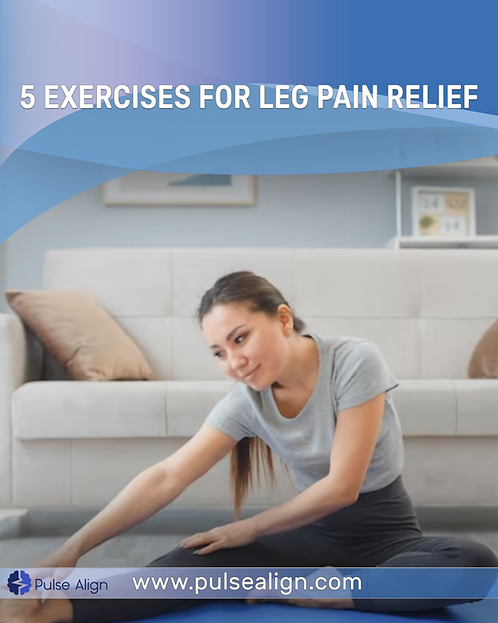Leg pain can be debilitating, affecting your ability to walk, stand, or even sit comfortably. Whether it stems from muscle strain, injury, or underlying health conditions, finding relief is paramount to restore mobility and enhance overall well-being. While medication may offer temporary relief, addressing the root causes of leg pain through targeted exercises and holistic approaches like Pulse Align can lead to lasting improvements in your quality of life.
The prevalence of lower limb pain among adults rises with age, starting at 21.0% among individuals aged 18–29, increasing to 28.8% among those aged 30–44, and further to 43.4% among individuals aged 45–64. Among those aged 65 and over, the prevalence reaches 50.3%.
In this comprehensive blog, we’ll explore five effective exercises tailored to alleviate leg pain while shedding light on the benefits of Pulse Align in addressing underlying issues. Let’s delve into each exercise, understanding its mechanics, benefits, and how it contributes to long-term pain relief and improved mobility.
Understanding Leg Pain Relief
Before delving into specific exercises, it’s crucial to understand the concept of leg pain relief and its relationship with addressing root causes. While conventional treatments often focus on symptom management, holistic approaches like Pulse Align emphasize identifying and correcting underlying imbalances to promote natural healing and long-term wellness.
Stretching: A Foundation for Leg Pain Relief
Stretching exercises play a pivotal role in alleviating leg pain by improving flexibility, enhancing circulation, and reducing muscle tension. Incorporating dynamic stretches like leg swings, calf stretches, and hamstring stretches can effectively target tight muscles and alleviate discomfort associated with leg pain.
Studies have shown that regular stretching not only reduces muscle soreness and stiffness but also enhances overall joint function, making it an essential component of any leg pain relief regimen.
Strengthening Exercises
Weak muscles can exacerbate leg pain and increase the risk of injury. By incorporating strengthening exercises targeting the quadriceps, hamstrings, calves, and glutes, individuals can improve muscle tone, stability, and endurance, thereby reducing strain on the affected areas.
Exercises such as squats, lunges, leg presses, and calf raises not only build strength but also enhance joint support and improve overall biomechanics, contributing to long-term pain relief and injury prevention.
Low-Impact Cardio: Enhancing Circulation and Mobility
Engaging in low-impact cardiovascular exercises such as walking, swimming, and cycling can enhance blood flow, promote tissue healing, and alleviate leg pain associated with poor circulation or inflammation.
Research suggests that regular aerobic exercise not only reduces pain intensity but also enhances mood, cognition, and overall well-being, making it a valuable component of holistic leg pain management strategies.
Balance and Stability Training: Preventing Falls and Injuries
Balance and stability exercises are essential for individuals experiencing leg pain, as they help improve proprioception, coordination, and postural alignment, reducing the risk of falls and injuries.
Incorporating activities like yoga, Tai Chi, and balance drills into your routine can enhance core strength, proprioceptive awareness, and neuromuscular control, fostering greater stability and resilience in daily activities.
Myofascial Release: Relieving Tension and Discomfort
Myofascial release techniques such as foam rolling, trigger point therapy, and massage can effectively alleviate muscle tightness, trigger points, and adhesions, providing immediate relief from leg pain and discomfort.
By targeting specific areas of tension and restriction, myofascial release promotes relaxation, improves tissue mobility, and enhances circulation, facilitating the body’s natural healing processes and promoting long-term pain relief.
The Role of Pulse Align in Addressing Root Causes
While exercises offer significant benefits in alleviating leg pain, addressing root causes is paramount for sustained relief and improved well-being. Pulse Align, a holistic approach that focuses on restoring balance and function to the body’s systems, offers a comprehensive solution for individuals seeking long-term pain relief and optimal health.
By utilizing advanced technology and personalized protocols, Pulse Align identifies underlying imbalances and dysfunctions, allowing for targeted interventions that address the root causes of leg pain rather than merely masking symptoms.
Studies have shown that Pulse Align not only reduces pain and inflammation but also enhances tissue regeneration, improves range of motion, and accelerates recovery from musculoskeletal injuries, making it a valuable adjunct to traditional therapies and exercise regimens.
Conclusion: Embracing Holistic Wellness with Pulse Align
In conclusion, leg pain relief is attainable through a combination of targeted exercises, holistic approaches, and lifestyle modifications. By addressing root causes and focusing on long-term healing, individuals can experience lasting improvements in mobility, comfort, and overall quality of life.
We invite you to explore the transformative benefits of Pulse Align and embark on a journey toward holistic wellness and vitality. Embrace lifestyle changes, prioritize self-care, and discover the power of Pulse Align in restoring balance, function, and vitality to your life.
Remember, true healing encompasses more than the elimination of symptoms – it entails a natural return to well-being, achieved through comprehensive care and a commitment to holistic wellness. Together, let’s embark on a path of healing, vitality, and optimal health with Pulse Align as our guide.
Reference
Lucas, J. W., Connor, E. M., & Bose, J. (2021). Back, lower limb, and upper limb pain among US adults, 2019.https://www.cdc.gov/nchs/products/databriefs/db415.htm
As the visionary CEO of Pulse Align, François is dedicated to transforming the landscape of pain management and posture health. With a deep-rooted passion for innovation and a commitment to excellence, François leads the team in developing cutting-edge solutions that empower individuals to live healthier, pain-free lives. Under his leadership, Pulse Align has become a beacon of hope and support for those navigating postural-related issues and chronic pain. François brings a wealth of experience in neuromodulation and patient management technologies, combining strategic insight with a compassionate approach to address the unique challenges faced by each individual.




